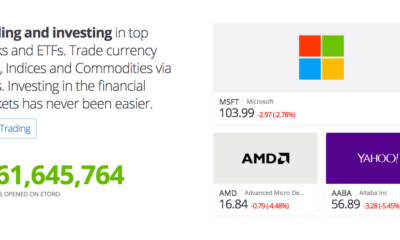NEW YORK, NY — December 18, 2018 — A new survey from eToro U.S., a leading global investment platform, finds that despite a clear interest in investing in cryptoassets, education is the key barrier preventing online investors from purchasing the asset. Of all online investors — including those who do or do not currently invest in cryptoassets — 69 percent of respondents were interested or very interested in learning about it.
However, the nationwide survey of 1,000 online investors found that proficiency in the cryptoasset class is still low. Three-quarters of those who do not hold the asset class state that they are not knowledgeable about cryptoassets. Even among investors who do invest in cryptoassets, over one-fifth of respondents feel that their understanding is lacking.
 Guy Hirsch, U.S. managing director, eToro, says: “Late 2018 has seen the cryptocurrency market take a huge tumble, but that has not stymied investors’ interest in the asset class and its potential. Online investors are still keeping their eye on cryptocurrencies, but this survey revealed that there is a serious lack of educational resources available to those who would like to invest in or learn more about crypto. As we move toward a future where assets will become increasingly tokenized, it’s important to give investors access to the resources they need to invest in the assets they want and truly consider cryptoassets as part of their long-term investment plan.”
Guy Hirsch, U.S. managing director, eToro, says: “Late 2018 has seen the cryptocurrency market take a huge tumble, but that has not stymied investors’ interest in the asset class and its potential. Online investors are still keeping their eye on cryptocurrencies, but this survey revealed that there is a serious lack of educational resources available to those who would like to invest in or learn more about crypto. As we move toward a future where assets will become increasingly tokenized, it’s important to give investors access to the resources they need to invest in the assets they want and truly consider cryptoassets as part of their long-term investment plan.”
Professional Crypto Education is Severely Lacking
Across the board, education is a key barrier preventing people from investing in cryptocurrency. Almost half (44 percent) of online investors state that education is the main reason for not trading crypto. This is true even among Millennials, who are more knowledgeable about the asset class than other generations. Forty percent of Millennials who do not invest in cryptoassets say that the lack of education is the main reason they do not invest.
Currently, there are limited resources when it comes to learning about cryptoassets. Investors who are invested in crypto mostly lean on observing their online trading platform (67 percent) and social media (43 percent) for guidance. Among social media channels, YouTube and online crypto chat forums are most used. When it comes to approach, those who currently invest, plan to invest or are interested in investing identified the following top three approaches to learning more about investing in crypto:
-
Start with a low amount of investment to test out the market (92 percent interested or very interested)
-
Watch an experienced trader to mimic their portfolio or trading patterns (85 percent interested or very interested)
-
Research cryptoassets using online channels (82 percent interested or very interested)
Despite the lack of knowledge and resources, 97 percent of both Millennial and Gen X crypto-traders are interested in learning more about cryptoassets, presenting a big opportunity to provide more formal training and structured resources.
Women Trade Crypto Less Than Men, But Not for Lack of Interest
 Across all groups of online investors who do not currently invest in cryptoassets, the top three barriers to participating in the asset class are consistent: price volatility, fear of scams, and lack of education or knowledge. However, the top reason for not trading differed significantly between men and women.
Across all groups of online investors who do not currently invest in cryptoassets, the top three barriers to participating in the asset class are consistent: price volatility, fear of scams, and lack of education or knowledge. However, the top reason for not trading differed significantly between men and women.
While men identified price volatility as the top barrier to trading crypto (41 percent), over half (51 percent) of women identified the lack of education or knowledge as the top reason for not trading. For women, the lack of educational resources is significantly more likely to affect whether they will take advantage of the asset class than men (39 percent).
While female investors are more likely to state that they are not well-versed in cryptocurrency trading (76 percent vs. 54 percent male), this doesn’t mean that women are less interested in learning about digital currencies. Of those who do not trade crypto, men and women are equally interested in learning about it — 61 percent of both genders were interested or very interested in more education.
Hirsch continues: “The investment gap between men and women is still quite stark. There are many studies that indicate this, and we are beginning to see companies provide more financial services tailored specifically for women. With cryptoassets, we need to begin closing the gap now by providing education and resources so more women feel comfortable tapping into the asset class while it is still in its relative infancy.”
Desire for Financial Advice in Cryptoassets
When it comes to financial advice, Millennials are more likely than Gen X or Boomer online investors to also make use of financial advisors. While 19 percent of Millennials planned on using a financial advisor to buy or sell products such as stocks, ETFs, or cryptoassets, only 11 percent of Gen X and 12 percent of Boomers indicated the same. Looking six months into the future indicates similar results. Twenty three percent of Millennials plan on using more resources such as financial advisors compared to only 14 percent of Gen X.
The results were even more apparent for those who currently do not plan on investing in crypto. Seventy three percent of Millennial investors would be significantly more likely to invest in crypto if advised by a financial advisor, compared to 58 percent of Gen X and 49 percent of Boomers.
Hirsch concludes: “It’s very encouraging to see that Millennials are in favor of using financial advisors. This makes sense as the top of the Millennial generation is approaching 40 and is starting to accumulate significant amount of wealth and are looking at their investments over the long term. Financial advisors have a lot of opportunity to tap into crypto as an asset class. There is clearly a demand — especially among Millennials — to include cryptoassets as part of a long-term investment strategy.”
About the Survey
eToro commissioned Provoke Insights, an independent market research and strategy firm, to conduct an online survey among 1,000 online investors. The sample matched the U.S. Census for geography and age (20-65), to get an accurate depiction of the online trading community. To garner a sufficient number of cryptocurrency traders, the research oversampled cryptocurrency by 285 respondents. The survey was distributed in September of 2018.
Statistical differences between subgroups were tested at a 90% confidence level. Margin of error is +/- 3%.
Disclaimer: Readers should do their own due diligence before taking any actions related to the company, product or service. BitcoinAfrica.io is not responsible, directly or indirectly, for any loss or damage caused by or in connection with the use of or reliance on any content, product or service mentioned in this press release.


 Features2 years ago
Features2 years ago
 Bitcoin2 years ago
Bitcoin2 years ago
 Features2 years ago
Features2 years ago
 Features2 years ago
Features2 years ago
 Features2 years ago
Features2 years ago
 Features2 years ago
Features2 years ago
 Features3 years ago
Features3 years ago
 Features6 months ago
Features6 months ago
 Guy Hirsch, U.S. managing director,
Guy Hirsch, U.S. managing director,  Across all groups of online investors who do not currently invest in cryptoassets, the top three barriers to participating in the asset class are consistent: price volatility, fear of scams, and lack of education or knowledge. However, the top reason for not trading differed significantly between men and women.
Across all groups of online investors who do not currently invest in cryptoassets, the top three barriers to participating in the asset class are consistent: price volatility, fear of scams, and lack of education or knowledge. However, the top reason for not trading differed significantly between men and women.









 1xBit has created Ticket Rush with numerous fanciful prizes that could change your entire gambling experience. With multiple prize draws designed to select many winners, you have a chance at winning big. The prize pool is 3 BTC, with numerous winners per category.
1xBit has created Ticket Rush with numerous fanciful prizes that could change your entire gambling experience. With multiple prize draws designed to select many winners, you have a chance at winning big. The prize pool is 3 BTC, with numerous winners per category.
 Tom also brought his creative mind to the forefront when brainstorming the new brand mission alongside the wider team. Crypto Lists had been searching for a new slogan, that is both accurate, descriptive, as well as evergreen – taking into consideration the future developments and growth of the company. Along with the senior leadership, a general consensus was reached: Crypto Done Smarter.
Tom also brought his creative mind to the forefront when brainstorming the new brand mission alongside the wider team. Crypto Lists had been searching for a new slogan, that is both accurate, descriptive, as well as evergreen – taking into consideration the future developments and growth of the company. Along with the senior leadership, a general consensus was reached: Crypto Done Smarter.
